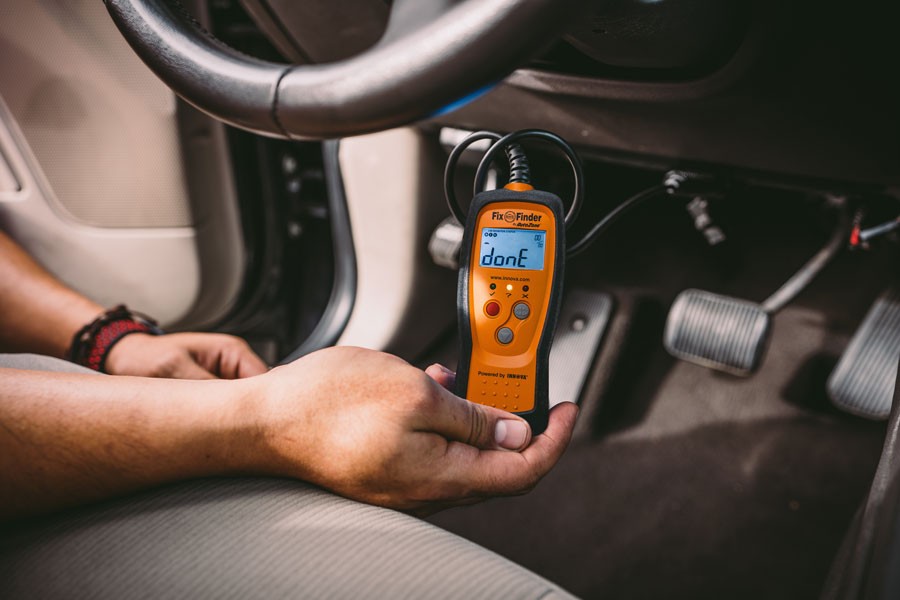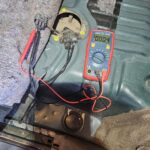Understanding your vehicle’s health is crucial for any car owner. Modern vehicles are equipped with an On-Board Diagnostics II (OBD2) system, a standardized system that provides access to your car’s computer. The gateway to this system is the OBD2 connector, and knowing how to “wire” – or more accurately, connect – your OBD2 scanner to this port is the first step in diagnosing issues yourself. This guide will walk you through the simple process of connecting your OBD2 scanner, empowering you to read diagnostic trouble codes and gain insights into your car’s performance.
Connecting an OBD2 scanner is surprisingly straightforward. In almost every passenger car manufactured since 1996, you’ll find the OBD2 port located inside the cabin. This port is a 16-pin, trapezoid-shaped female connector, and it’s typically positioned beneath the dashboard on the driver’s side. While less common, it can sometimes be found in the center console or under the passenger side dashboard.
The OBD2 connector is designed for easy use. The male plug of your OBD2 scanner is shaped to fit perfectly in only one orientation. Simply align the trapezoidal shape of your scanner’s plug with the OBD2 port in your car. Then, gently but firmly push the two connectors together. You might feel a slight resistance, and a little wiggle can help ensure a secure connection.
Here’s the recommended sequence for connecting your OBD2 scanner:
- Turn Off the Ignition: Ensure your car’s ignition is completely off before you begin. This is a standard safety precaution for any automotive electrical work.
- Locate and Connect: Find the OBD2 diagnostic port in your vehicle. Once located, plug your OBD2 scan tool into the port.
- Turn Ignition to ‘On’ (Engine Off): Turn your car key to the “on” position in the ignition. This will power up your car’s electrical systems, but do not start the engine.
- Power Up Scan Tool: In most cases, the OBD2 port itself will provide power to your scan tool. You should see your scanner power on.
- Wait for Boot Sequence: Allow your OBD2 scanner to complete its startup or boot sequence. This may take a few moments.
Once your scanner is powered and initialized, it will usually guide you through any additional required information. This might include prompting you to enter your vehicle’s engine size, Vehicle Identification Number (VIN), or instructions on whether to start the engine or not for specific tests.
Related: What Does U0100 Code Mean?
Navigating the OBD2 Scanner Menu
After successfully connecting your OBD2 scanner and it has booted up, you will be presented with a menu on its screen. The options available in this menu can vary significantly depending on whether you are using a basic code reader or a more advanced diagnostic device. However, common menu options often include:
- Read Codes: Selecting this option instructs the scanner to retrieve any stored Diagnostic Trouble Codes (DTCs). The scanner will display the DTC number and may also provide a brief text description of the issue. If multiple codes are present (either currently active or pending), the scanner will usually cycle through each of them.
- Erase Codes: This function allows you to clear stored DTCs from your vehicle’s computer. Typically, when you select this option, the scanner will ask for confirmation before proceeding to ensure you don’t accidentally erase important diagnostic information. Clearing codes essentially removes the record of past faults from the system’s memory.
- Live Data: For scanners equipped with live data capabilities, this option provides real-time sensor readings from various systems within your car. You can scroll through lists of parameters, observing live values to identify sensors operating outside of normal ranges or sensors that are not registering changes in value at all, which can indicate a malfunction.
- Freeze Frame: This is a valuable feature that captures a snapshot of crucial sensor parameters at the precise moment a DTC was triggered and stored. Freeze frame data provides important context and can be very helpful in diagnosing intermittent problems.
- Vehicle Info: This section typically displays basic information about your vehicle, often retrieved directly from the car’s computer system. This can include the VIN and other build-related data.
- I/M Readiness: Short for Inspection and Maintenance Readiness, this section is particularly relevant for emissions testing. It checks the status of various emissions-related systems and indicates whether your vehicle is ready for a smog check. It can highlight potential issues that might prevent your car from passing an emissions test.
Most OBD2 scanners, even Bluetooth or Wi-Fi models controlled via smartphone apps, will have physical buttons for navigation. Arrow buttons are used to scroll through menu options, and a selection button is used to confirm your choice. A ‘back’ button is also commonly included to navigate back to the previous menu screen.
Decoding Trouble Codes
 OBD-II scanner displaying diagnostic trouble codes
OBD-II scanner displaying diagnostic trouble codes
When you choose “Read Codes” on your OBD2 scanner, it will display a code that requires interpretation. Sometimes, a brief description of the fault might be shown on the screen, but this is not always the case. OBD2 codes follow a consistent format: a single letter followed by four numerical digits, like P0301.
The initial letter of the code provides the first level of categorization, indicating which vehicle system is involved:
- P (Powertrain): This indicates issues related to the powertrain system, which includes the engine, transmission, emissions controls, and fuel system. Powertrain codes are the most frequently encountered.
- B (Body): Body codes relate to body control systems. This can include problems with airbags, power windows, interior lighting, and other systems related to the vehicle’s body and interior functions.
- C (Chassis): Chassis codes point to problems within the chassis systems. This category includes issues with the suspension, braking system (ABS), power steering, and other systems related to the vehicle’s structural and handling components.
- U (Network or Communication): “U” codes indicate network or communication issues. These codes signal problems with the communication network within the vehicle, often involving the Controller Area Network (CAN bus) and communication between different electronic control units (ECUs).
The numbers that follow the letter provide further specificity. The first numerical digit is always either a ‘0’ or a ‘1’. A ‘0’ in this position signifies that the code is a generic OBD2 code. Generic codes are standardized across all vehicle manufacturers, meaning a P0XXX code will have the same general meaning regardless of the car brand. If the first number is a ‘1’, it indicates a manufacturer-specific code. These codes are defined by the individual car manufacturer and may have slightly different meanings or troubleshooting procedures compared to generic codes.
The subsequent digits further pinpoint the system and the specific fault. The second numerical digit after the ‘0’ or ‘1’ categorizes the system involved in more detail:
- 1: Fuel and Air Metering system related faults.
- 2: Fuel and Air Metering – specifically related to injector circuit issues.
- 3: Ignition System or Misfire faults.
- 4: Auxiliary Emission Controls system problems.
- 5: Vehicle Speed Control or Idle Control System faults.
- 7, 8, 9: Transmission-related codes.
- A, B, C: Hybrid-specific codes (for hybrid vehicles).
The final two digits of the OBD2 code provide even more granular detail, identifying the specific component or circuit that is malfunctioning. There are hundreds of possible combinations for these last digits, each with a specific description.
Using our example code P0301 again, we can break it down: ‘P’ indicates a Powertrain code, ‘0’ signifies it’s a generic code, ‘3’ points to the Ignition system or a misfire, and ’01’ specifically indicates a misfire detected in cylinder #1. Therefore, P0301 translates to “Cylinder 1 Misfire Detected.”
Saving Money with OBD2 Scanners
Owning an OBD2 scanner can translate to significant savings in vehicle maintenance costs in several ways. Firstly, if your Check Engine Light illuminates or you notice a performance issue, a quick scan with your OBD2 tool can give you an initial indication of the potential problem area. While it doesn’t provide a definitive diagnosis in every case, it serves as a valuable first step in understanding what might be wrong.
Secondly, an OBD2 scanner can help you determine if your car is likely to pass an upcoming emissions or smog check. The I/M Readiness test function provides insight into the status of emissions-related systems. Identifying a potential issue beforehand can allow you to address it before going for the test, preventing a failed inspection and the associated re-test fees.
Furthermore, if you are comfortable with DIY car repairs, an OBD2 scanner can potentially save you money on both diagnostics and repairs. For instance, a code like P0138, indicating “O2 Sensor Circuit High Voltage (Bank 1 Sensor 2),” points directly to a problem with the bank 1 sensor 2 oxygen sensor. In many cases, replacing the sensor is a straightforward DIY repair. By using your OBD2 scanner to read and clear the codes after replacing the sensor, you can avoid diagnostic fees at a repair shop and handle the repair yourself.
AutoZone offers a range of OBD2 scanners to suit different needs and budgets, empowering you to expand your DIY automotive capabilities. Additionally, explore AutoZone’s Loan-A-Tool program, which allows you to borrow specialized tools, including OBD2 scanners, at no cost, making car diagnostics even more accessible.
FAQ/People Also Ask
How do you use an OBD II scanner?
Connect the scanner to the OBD2 port under your dashboard, turn the ignition to the ‘on’ position (engine off), and follow the on-screen prompts on the scanner.
Does the car have to be running to use an OBD2 scanner?
No, in most situations, you can read trouble codes with the ignition switched to the ‘ON’ position, without the engine running.
How do I interpret my OBD scanner readings?
Select “read codes” on your scanner screen and note down the displayed diagnostic trouble codes (DTCs). The letter in the code indicates the affected system, and the numbers provide more specific fault information.
Is it safe to plug in an OBD scanner while the car is running?
While technically possible, it’s generally not recommended to plug in or unplug an OBD scanner while the engine is running. It’s best practice to switch the ignition off before connecting or disconnecting the scanner. If you need to initiate a test with the scanner, you may need to cycle the ignition off and then back to the ‘on’ position as instructed by the scanner.
